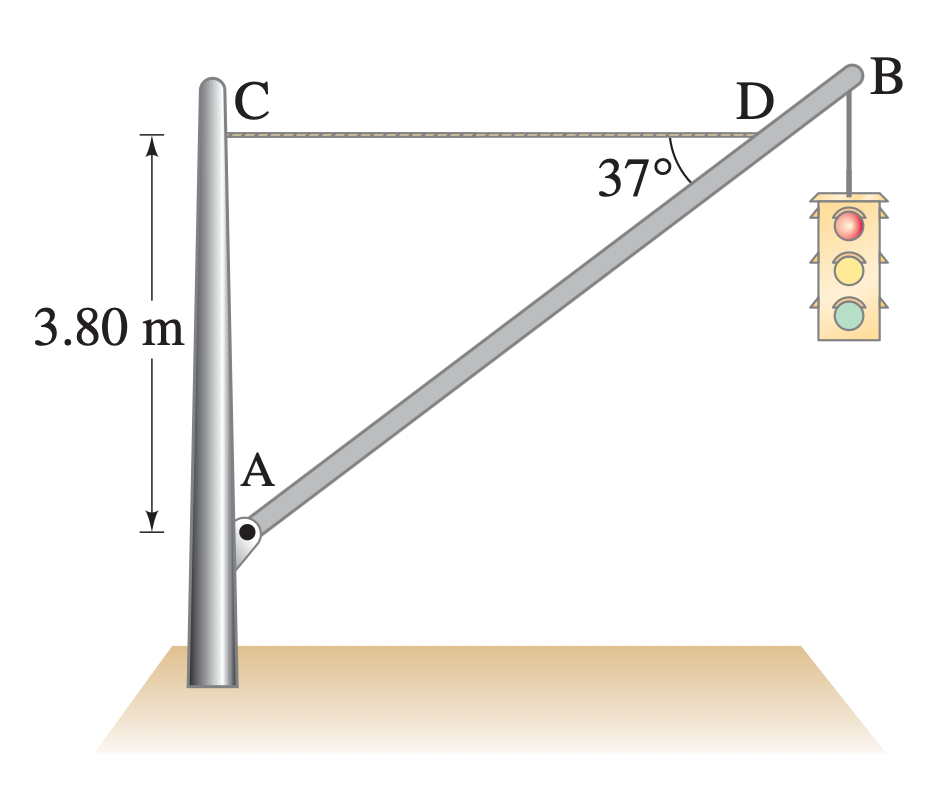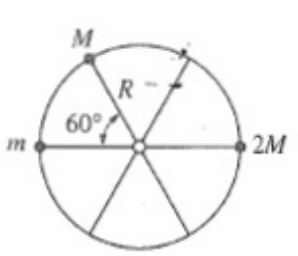0 attempts
0% avg
UBQ Credits
| Step | Derivation/Formula | Reasoning |
|---|---|---|
| (a) | \[\alpha = \frac{\Delta\omega}{\Delta t}=\frac{-30-60}{6-2}=\frac{-90}{4}=-22.5\,\text{rad\,/s}^2\] | The interval from \(t=2\,\text{s}\) to \(t=6\,\text{s}\) is a straight line, so the slope (constant) gives the instantaneous angular acceleration at any time in that portion, including \(t=4\,\text{s}.\) |
| (b) | \[v=r\,\omega = 0.25\,\text{m}\times 60\,\text{rad\,/s}=15\,\text{m\,/s}\] | At \(t=1\,\text{s}\) the graph is flat at \(\omega = 60\,\text{rad\,/s}.\) Linear (rim) speed is \(v=r\omega.\) |
| (c) | \[\Delta\theta_{0\!\to 2}=\omega\,\Delta t = 60\,\text{rad\,/s}\times 2\,\text{s}=120\,\text{rad}\] | From 0–2 s the angular velocity is constant, so the area under the \(\omega\)-vs-\(t\) graph (a rectangle) is \(\omega\Delta t.\) |
| (d) | \[\omega_f = \omega_i + \alpha\,\Delta t = 60 + (-22.5)(2)=15\,\text{rad\,/s}\] \[\Delta\theta_{2\!\to 4}=\tfrac12(\omega_i+\omega_f)\,\Delta t = \tfrac12(60+15)\times 2 = 75\,\text{rad}\] |
The segment 2–4 s lies on the linear portion with constant \(\alpha.\) Use kinematics (or trapezoid area) with \(\omega_i=60\,\text{rad\,/s}\) and \(\omega_f=15\,\text{rad\,/s}.\) |
| (e) | \[\begin{aligned} \Delta\theta_{0\!\to 2}&=120\\[4pt] \Delta\theta_{2\!\to 6}&=\tfrac12(60+(-30))(4)=60\\[4pt] \Delta\theta_{6\!\to 8}&=(-30)(2)=-60\\[4pt] \Delta\theta_{8\!\to 10}&=\tfrac12(-30+0)(2)=-30\\[4pt] \theta_{\text{total}}&=120+60-60-30=90\,\text{rad} \end{aligned}\] |
Sum the signed areas (trapezoids/rectangles) for each time interval. Positive areas correspond to counter-clockwise rotation; negative areas to clockwise. |
| (f) | \[\Delta x = r\,\theta_{\text{total}} = 0.25\,\text{m}\times 90\,\text{rad}=22.5\,\text{m}\] | For rolling without slipping, the center of mass translates a linear distance equal to \(r\,\Delta\theta.\) |
| (g) | \[a_{\text{tan}} = r\,|\alpha| = 0.25\,\text{m}\times 22.5\,\text{rad\,/s}^2 = 5.6\,\text{m\,/s}^2\] | Magnitude of tangential acceleration is the product of radius and magnitude of angular acceleration at \(t=4\,\text{s}.\) |
| (h) | \[a_{\text{tan}} = r\,\alpha = 0.25\times 0 = 0\,\text{m\,/s}^2\] \[v = r\omega = 0.25\times 60 = 15\,\text{m\,/s}\quad\Rightarrow\quad a_{c}=\frac{v^2}{r}=\frac{15^2}{0.25}=900\,\text{m\,/s}^2\] |
At \(t=1\,\text{s}\) the graph is flat, so \(\alpha=0\Rightarrow a_{\text{tan}}=0.\) Centripetal acceleration depends on instantaneous speed: \(a_c = v^2/r.\) |
Just ask: "Help me solve this problem."

A traffic light hangs from a pole as shown in the diagram. The uniform aluminum pole AB is of length \( 7.20 \) \( \text{m} \) and has a mass of \( 12.0 \) \( \text{kg} \). The mass of the traffic light is \( 21.5 \) \( \text{kg} \). The point C is located \( 3.80 \) \( \text{m} \) vertically above the pivot A. A massless horizontal cable CD is attached at C and connects to the pole at point D, where the pole makes an angle of \( 37^{\circ} \) with the cable.

A point on the edge of a disk rotates around the center of the disk with an initial angular velocity of 3 rad/s clockwise. The graph shows the point’s angular acceleration as a function of time. The positive direction is considered to be counterclockwise. All frictional forces are considered to be negligible.

A wheel of radius \( R \) and negligible mass is mounted on a horizontal frictionless axle so that the wheel is in a vertical plane. Three small objects having masses \( m \), \( M \), and \( 2M \), respectively, are mounted on the rim of the wheel, as shown above. If the system is in static equilibrium, what is the value of \( m \) in terms of \( M \)?
A spinning ice skater on extremely smooth ice is able to control the rate at which she rotates by pulling in her arms. Which of the following statements are true about the skater during this process?
A turntable rotates through \( 6 \) \( \text{rad} \) in \( 3 \) \( \text{s} \) as it accelerates uniformly from rest. What is its angular acceleration in \( \text{rad/s}^2 \)?
By continuing you (1) agree to our Terms of Use and Terms of Sale and (2) consent to sharing your IP and browser information used by this site’s security protocols as outlined in our Privacy Policy.
| Kinematics | Forces |
|---|---|
| \(\Delta x = v_i t + \frac{1}{2} at^2\) | \(F = ma\) |
| \(v = v_i + at\) | \(F_g = \frac{G m_1 m_2}{r^2}\) |
| \(v^2 = v_i^2 + 2a \Delta x\) | \(f = \mu N\) |
| \(\Delta x = \frac{v_i + v}{2} t\) | \(F_s =-kx\) |
| \(v^2 = v_f^2 \,-\, 2a \Delta x\) |
| Circular Motion | Energy |
|---|---|
| \(F_c = \frac{mv^2}{r}\) | \(KE = \frac{1}{2} mv^2\) |
| \(a_c = \frac{v^2}{r}\) | \(PE = mgh\) |
| \(T = 2\pi \sqrt{\frac{r}{g}}\) | \(KE_i + PE_i = KE_f + PE_f\) |
| \(W = Fd \cos\theta\) |
| Momentum | Torque and Rotations |
|---|---|
| \(p = mv\) | \(\tau = r \cdot F \cdot \sin(\theta)\) |
| \(J = \Delta p\) | \(I = \sum mr^2\) |
| \(p_i = p_f\) | \(L = I \cdot \omega\) |
| Simple Harmonic Motion | Fluids |
|---|---|
| \(F = -kx\) | \(P = \frac{F}{A}\) |
| \(T = 2\pi \sqrt{\frac{l}{g}}\) | \(P_{\text{total}} = P_{\text{atm}} + \rho gh\) |
| \(T = 2\pi \sqrt{\frac{m}{k}}\) | \(Q = Av\) |
| \(x(t) = A \cos(\omega t + \phi)\) | \(F_b = \rho V g\) |
| \(a = -\omega^2 x\) | \(A_1v_1 = A_2v_2\) |
| Constant | Description |
|---|---|
| [katex]g[/katex] | Acceleration due to gravity, typically [katex]9.8 , \text{m/s}^2[/katex] on Earth’s surface |
| [katex]G[/katex] | Universal Gravitational Constant, [katex]6.674 \times 10^{-11} , \text{N} \cdot \text{m}^2/\text{kg}^2[/katex] |
| [katex]\mu_k[/katex] and [katex]\mu_s[/katex] | Coefficients of kinetic ([katex]\mu_k[/katex]) and static ([katex]\mu_s[/katex]) friction, dimensionless. Static friction ([katex]\mu_s[/katex]) is usually greater than kinetic friction ([katex]\mu_k[/katex]) as it resists the start of motion. |
| [katex]k[/katex] | Spring constant, in [katex]\text{N/m}[/katex] |
| [katex] M_E = 5.972 \times 10^{24} , \text{kg} [/katex] | Mass of the Earth |
| [katex] M_M = 7.348 \times 10^{22} , \text{kg} [/katex] | Mass of the Moon |
| [katex] M_M = 1.989 \times 10^{30} , \text{kg} [/katex] | Mass of the Sun |
| Variable | SI Unit |
|---|---|
| [katex]s[/katex] (Displacement) | [katex]\text{meters (m)}[/katex] |
| [katex]v[/katex] (Velocity) | [katex]\text{meters per second (m/s)}[/katex] |
| [katex]a[/katex] (Acceleration) | [katex]\text{meters per second squared (m/s}^2\text{)}[/katex] |
| [katex]t[/katex] (Time) | [katex]\text{seconds (s)}[/katex] |
| [katex]m[/katex] (Mass) | [katex]\text{kilograms (kg)}[/katex] |
| Variable | Derived SI Unit |
|---|---|
| [katex]F[/katex] (Force) | [katex]\text{newtons (N)}[/katex] |
| [katex]E[/katex], [katex]PE[/katex], [katex]KE[/katex] (Energy, Potential Energy, Kinetic Energy) | [katex]\text{joules (J)}[/katex] |
| [katex]P[/katex] (Power) | [katex]\text{watts (W)}[/katex] |
| [katex]p[/katex] (Momentum) | [katex]\text{kilogram meters per second (kgm/s)}[/katex] |
| [katex]\omega[/katex] (Angular Velocity) | [katex]\text{radians per second (rad/s)}[/katex] |
| [katex]\tau[/katex] (Torque) | [katex]\text{newton meters (Nm)}[/katex] |
| [katex]I[/katex] (Moment of Inertia) | [katex]\text{kilogram meter squared (kgm}^2\text{)}[/katex] |
| [katex]f[/katex] (Frequency) | [katex]\text{hertz (Hz)}[/katex] |
General Metric Conversion Chart
Example of using unit analysis: Convert 5 kilometers to millimeters.
Start with the given measurement: [katex]\text{5 km}[/katex]
Use the conversion factors for kilometers to meters and meters to millimeters: [katex]\text{5 km} \times \frac{10^3 \, \text{m}}{1 \, \text{km}} \times \frac{10^3 \, \text{mm}}{1 \, \text{m}}[/katex]
Perform the multiplication: [katex]\text{5 km} \times \frac{10^3 \, \text{m}}{1 \, \text{km}} \times \frac{10^3 \, \text{mm}}{1 \, \text{m}} = 5 \times 10^3 \times 10^3 \, \text{mm}[/katex]
Simplify to get the final answer: [katex]\boxed{5 \times 10^6 \, \text{mm}}[/katex]
Prefix | Symbol | Power of Ten | Equivalent |
|---|---|---|---|
Pico- | p | [katex]10^{-12}[/katex] | 0.000000000001 |
Nano- | n | [katex]10^{-9}[/katex] | 0.000000001 |
Micro- | µ | [katex]10^{-6}[/katex] | 0.000001 |
Milli- | m | [katex]10^{-3}[/katex] | 0.001 |
Centi- | c | [katex]10^{-2}[/katex] | 0.01 |
Deci- | d | [katex]10^{-1}[/katex] | 0.1 |
(Base unit) | – | [katex]10^{0}[/katex] | 1 |
Deca- or Deka- | da | [katex]10^{1}[/katex] | 10 |
Hecto- | h | [katex]10^{2}[/katex] | 100 |
Kilo- | k | [katex]10^{3}[/katex] | 1,000 |
Mega- | M | [katex]10^{6}[/katex] | 1,000,000 |
Giga- | G | [katex]10^{9}[/katex] | 1,000,000,000 |
Tera- | T | [katex]10^{12}[/katex] | 1,000,000,000,000 |
The most advanced version of Phy. 50% off, for early supporters. Prices increase soon.
per month
Billed Monthly. Cancel Anytime.
Trial –> Phy Pro
We crafted THE Ultimate A.P Physics 1 course so you can learn faster and score higher.
Try our free calculator to see what you need to get a 5 on the upcoming AP Physics 1 exam.
A quick explanation
Credits are used to grade your FRQs and GQs. Pro users get unlimited credits.
Submitting counts as 1 attempt.
Viewing answers or explanations count as a failed attempts.
Phy gives partial credit if needed
MCQs and GQs are are 1 point each. FRQs will state points for each part.
Phy customizes problem explanations based on what you struggle with. Just hit the explanation button to see.
Understand you mistakes quicker.

Phy automatically provides feedback so you can improve your responses.
10 Free Credits To Get You Started

By continuing you agree to nerd-notes.com Terms of Service, Privacy Policy, and our usage of user data.
NEW! PHY AI accurately solves all questions
🔥 Get up to 30% off Elite Physics Tutoring
🧠 NEW! Learn Physics From Scratch Self Paced Course
🎯 Need exam style practice questions?